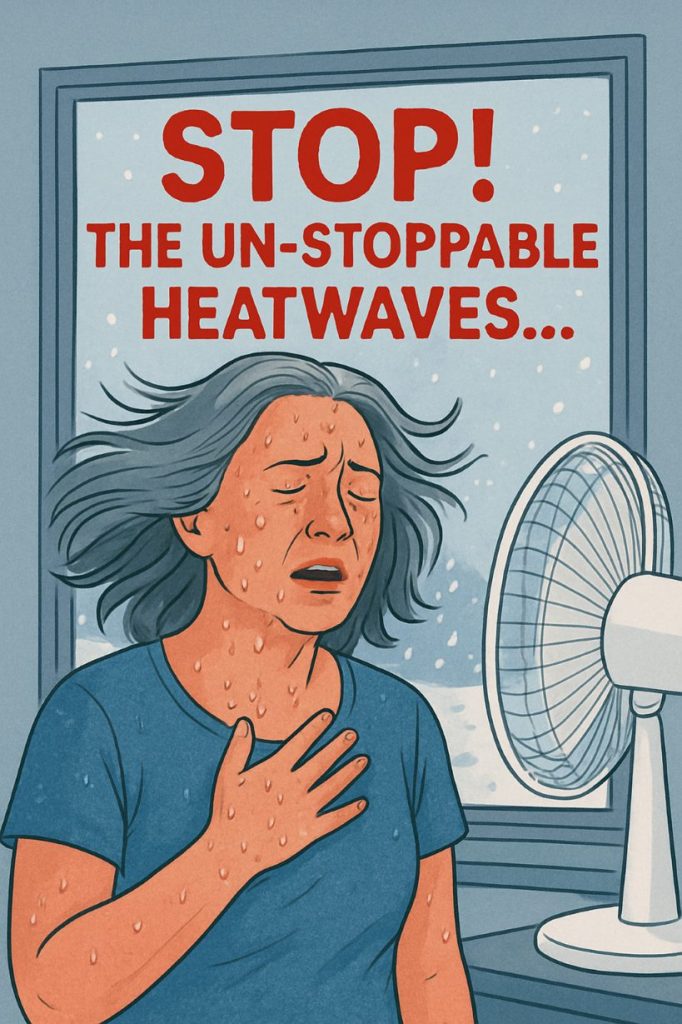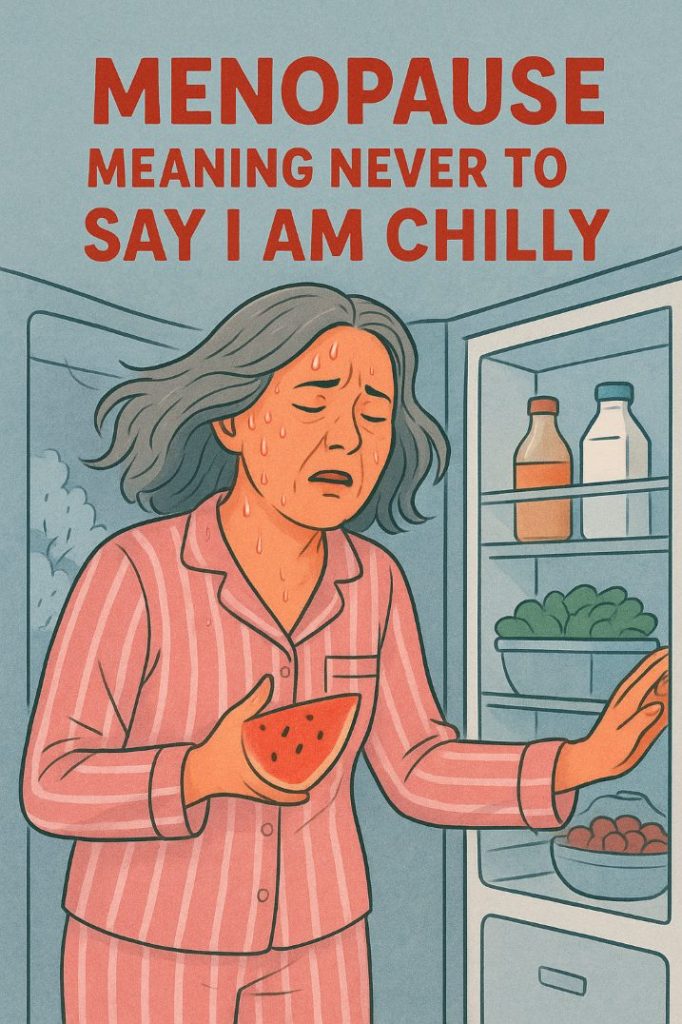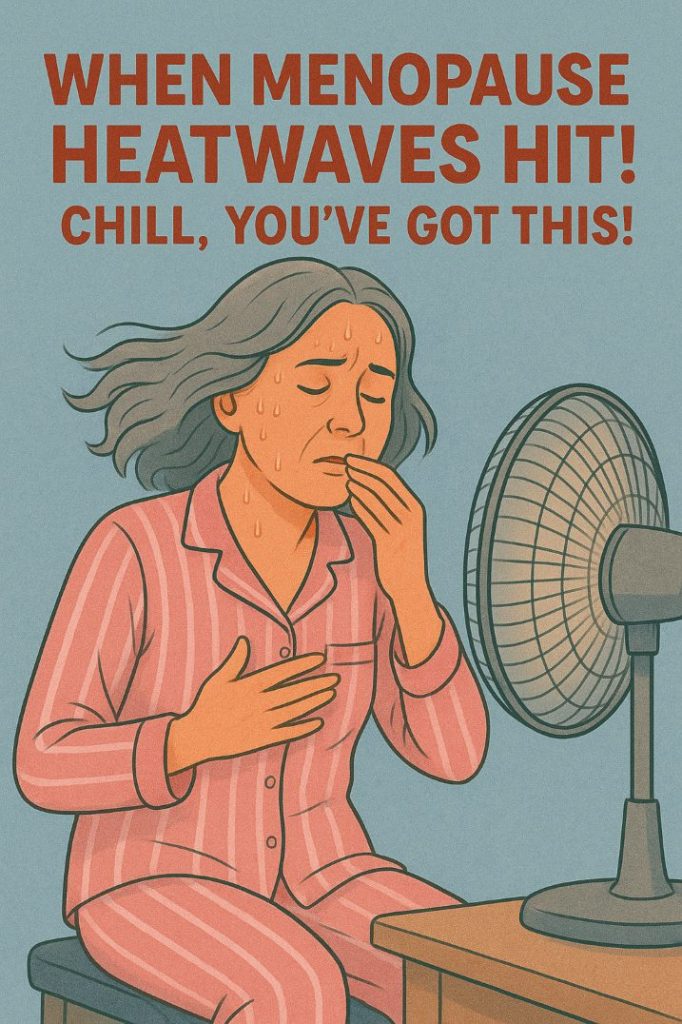Menopause is often accompanied by uncomfortable heat surges, otherwise known as hot flashes or vasomotor symptoms—an issue experienced by many women before, during, and after the final menstrual period. Trusted Source. For some this feels more like heatwaves than hot flashes.
As a nutritionist and menopause + breath work coach, one of my priorities is helping clients regain comfort and agency over these heat events through non-pharmacological, lifestyle-based cooling strategies. Below are routines—daily habits, breath work methods, and practical tools—you can use to help you cool down when those waves hit.
Why Cooling Routines Matter

Before diving into strategies, it helps to understand why cooling practices can work. Estrogen helps regulate the body’s “thermostat” via the hypothalamus; when estrogen levels fluctuate or decline, that thermostat becomes more sensitive, triggering heat surges more easily. Trusted Source
Cooling routines aim to:
- Lower core or skin temperature during a hot flash
- Shift the autonomic (nervous) balance toward parasympathetic (“rest & digest”) vs. sympathetic (“fight or flight”)
- Reduce stress or anxiety, which often amplify heat sensations
- Provide quick, actionable relief clients can use in the moment
Many of these strategies are low-risk and can complement medical or hormone therapies.
Daily Cooling Routines & Environmental Hacks
Here are tactics clients can build into their day-to-day to reduce frequency and intensity of heat events:

| Strategy | Practical Tips | Why It Helps / What Evidence Says |
|---|---|---|
| Dress in layers + breathable fabrics | Use light cotton or linen, wear button-ups or layers you can remove quickly; avoid tight or synthetic materials | Helps dissipate heat instead of trapping it. Trusted Source |
| Control indoor temperature | Use fans or air conditioning; keep rooms cool; use bed fans or cooling sheets at night | Keeping ambient temperature lower offers a buffer against sudden surges. Trusted Source |
| Cold packs / compresses | Keep a gel pack or ice pack in fridge; place on forehead, neck, or chest at first sign of flush | Local cooling can rapidly reduce thermal load. Trusted Source |
| Cool showers / baths | A quick cool shower or splashing cool water helps lower body temperature | Useful especially after activity or when heat builds. Trusted Sources |
| Stay well hydrated & eat cooling foods | Cold water, herbal teas; foods like cucumber, watermelon, leafy greens | Hydration supports thermoregulation, and cooling foods may mildly lower internal heat load. Trusted Source |
| Avoid or reduce triggers | Spicy food, caffeine, alcohol, hot drinks, tight environments | These often precipitate or worsen hot flashes. Trusted Source |
Clients may benefit from a hot flash “cool-kit”: a small spray bottle of cool water, cooling gel stick, a fabric cooling towel, or portable fan that fits in a bag. Trusted Source
Breath work & Mind-Body Techniques
Breathing practices and mind–body work can be a potent adjunct to cooling routines, especially because they help shift nervous tone and reduce internal agitation (which can trigger or amplify hot flashes).
1. Paced / Slow Ventilatory Breathing
One of the more studied techniques involves slowing the resting respiratory rate to below about 10 breaths/minute for 10–15 minutes daily. Trusted Source
- In a randomized trial, women practicing this device-guided slow breathing saw a modest reduction in hot flash frequency (~21%) over 12 weeks. Trusted Source
- Another trial comparing paced breathing twice a day vs. once a day found reductions up to ~52% in hot flashes. Trusted Source
- That said, some sources caution that evidence is still limited and results mixed. Trusted Source
How to do paced breathing:
- Sit comfortably with good posture
- Inhale slowly (e.g. count to 4 or 5)
- Exhale slowly (count to 4 or 5)
- Pause briefly before next inhale
- Repeat for 10–15 minutes, ideally 1–2× daily
- Practice this technique even when you are not experiencing a flush, so the pattern becomes familiar
2. Diaphragmatic (“Belly”) Breathing
This emphasizes deep filling of the lower lungs by engaging the diaphragm.
- A Turkish study found that menopausal women practicing diaphragmatic breathing had fewer complaints of hot flashes vs. controls. Trusted Source
- Breath work resources for menopause often recommend this technique to stabilize internal temperature during a surge. Trusted Source
3. Breath Practices for Menopause
Specific breathing techniques can support psychological well-being and help manage common menopausal symptoms. Techniques include:
- Bee breath – Promotes calming effects and reduces stress. Trusted Source
- Alternate nostril breathing – Supports relaxation and symptom management. Trusted Source
- Cooling breath technique – Inhale through a rolled tongue or pursed lips, exhale through the nose; helps regulate body temperature and promotes calm.
In addition, mind–body programs such as yoga, meditation, and tai chi have been shown to improve menopausal or vasomotor symptoms, with several studies reporting reductions in overall symptom burden.
Putting It All into a Routine: Sample Daily Protocol
Here’s an example of a “cooling day” routine you could try today!

Morning:
• Wake up and drink a glass of cool or room-temperature water
• 5–10 min diaphragmatic breathing
• Light, breathable clothing
• Avoid hot beverages or heavy clothes
Midday / During Work:
• Keep a spray bottle or damp cloth handy
• Use a fan, open windows, or manage air flow
• If a hot flash begins, pause and initiate breathing technique
• Wear layers that can be shed quickly
Afternoon / Evening:
• Enjoy hydrating foods/fruit
• Avoid spicy or overly hot meals
• Gentle movement (yoga, walking) in cooler parts of day
Pre-Bed / Night:
• End the day with a 10–15 min breath work session (paced breathing)
• Use cooling sheets, bed fan, or a cold pack under the pillow
• Keep bedroom temperature lower (e.g. ~18–20 °C or comfortable range) Trusted Source
You can adjust this to your schedules, sensitivity, or comfort.
Tips: Supporting Ideas During Implementation
- Start small: Introduce one or two cooling tools or breath techniques at a time.
- Encourage consistency over perfection: Even 5 minutes of paced breathing daily can help with habit formation.
- Personalize trial & error: Each woman has unique triggers—try journaling to see what works vs. what doesn’t.
- Check safety and comfort: Some may feel lightheaded with controlled breathing; always ensure seated position first.
- Blend with other support modalities: Use cooling routines alongside nutrition, sleep hygiene, stress work, and medical oversight.
- Track outcomes: Use a simple client log (daily frequency/intensity of hot flashes, usability of tools) to quantify progress over weeks.
Caveats & Considerations
- While many cooling and breath work methods are low-risk, the evidence base is still emerging; results vary across individuals. Trusted Source
- These strategies are complementary, not replacements for medical care, especially when hot flashes are severe or impacting quality of life.
- Consult your healthcare provider before making changes or combining with hormone therapies or medications.
Final Thought
Cooling routines are powerful because they offer immediate, tangible relief during hot flashes and help women feel more in control of their bodies. When paired with intentional breath work, they can serve as a bridge between body and mind, soothing both the physical heat surge and the internal reaction to it.
There is not a single magic bullet as a cure, but these techniques will empower each woman to find which mix of strategies works best for her. With patience, personalization, and gentle experimentation, women can reduce the burden of heat-related symptoms and reclaim comfort in this transition.

